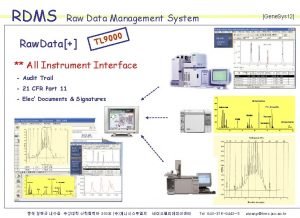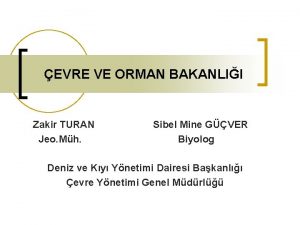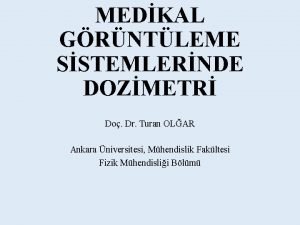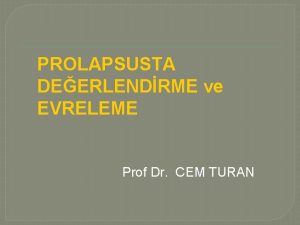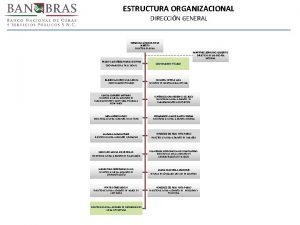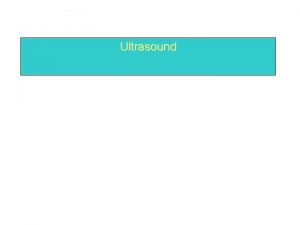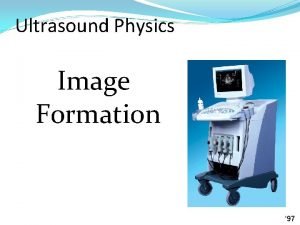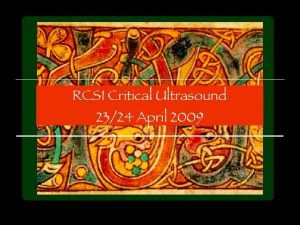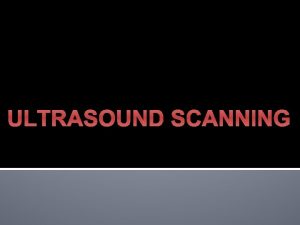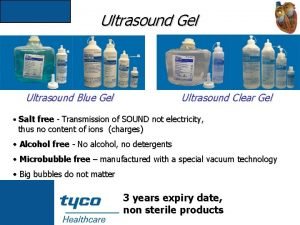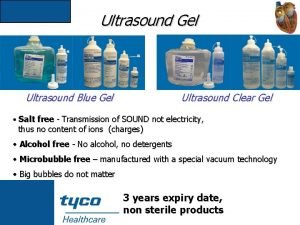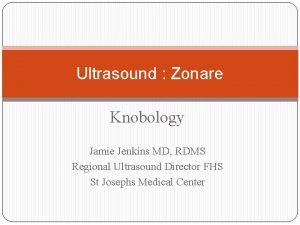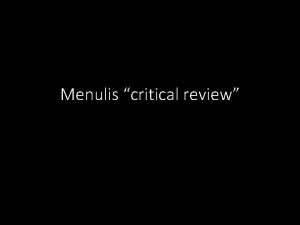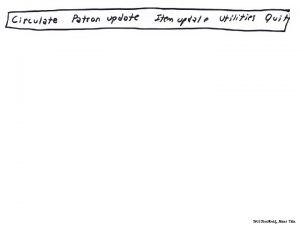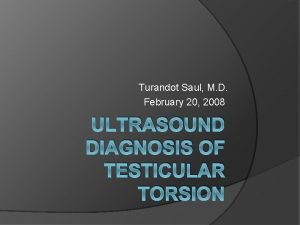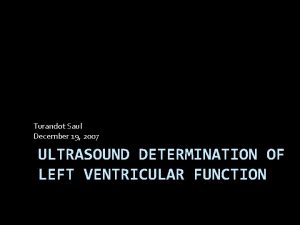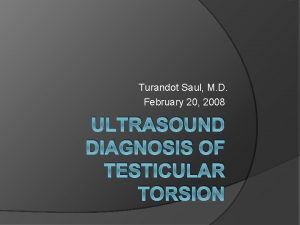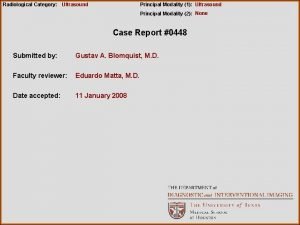Turan Saul M D RDMS Critical Ultrasound Review









































































- Slides: 73


Turan Saul, M. D. , RDMS Critical Ultrasound Review St. Luke’s Roosevelt Hospital Center EM Jeopardy. TM

$100 $100 $200 $200 $300 $300 $400 $400 $500 $500 $600 $600

Airway and Breathing

Cardiac and EFAST

Aorta and IVC

Venous Access And Soft Tissue

Pelvic And DVT

Cardiac and EFAST Aorta and IVC Vascular Access And Soft Tissue Pelvic and DVT $100 $100 $200 $200 $300 $300 $400 $400 $500 $500 $600 $600 Airway and Breathing

Thank You The Dublin College of Physicians and Surgeons Dr. John Cahill ‘ William H. Bagley, M. D. Resa Lewiss, M. D. , RDMS Paul Travnicek, M. D.

The above image demonstrates? A. Vertebral shadowing B. Esophagus C. Linear foreign body D. Tracheal rings E. None of the above

D – Tracheal Rings • Tracheal rings • Cricothyroid membrane • High frequency linear probe • Sagittal plane Characteristic sonographic appearance of normal anatomy SLRUS

Methods of assessing a successful intubation include visualizing? A. B. C. D. E. Bilateral, symmetric pleural sliding Visible comet-tail artifacts Symmetric diaphragmatic movement The bar code sign in M-mode A, B, and C

E - A, B, and C A. B. C. Bilateral, symmetric pleural sliding Visible comet-tail artifacts Symmetric diaphragmatic movement • These findings are normal, and do not raise concern for: - pneumothorax - right mainstem intubation • The barcode sign using M-mode occurs when there is a pneumothorax SLRUS

DAILY DOUBLE

The following image is concerning for an esophageal intubation because? A. B. C. D. E. The trachea is visible The esophagus is visible Impossible to tell from this image This is a normal image Need to evaluate in both transverse and sagittal planes.

B – The esophagus is visible • Esophagus is normally collapsed and not visible adjacent to the trachea • Posterior shadowing - trachea from cartilaginous rings - left para-tracheal area: esophagus opened by the endotracheal tube SLRUS

The batwing pattern represents? A. Viceral pleura, parietal pleura, rib B. Rib, intercostal space, rib C. A pattern of lung sliding and comet tails D. A way to determine if a pneumothorax is present

B. Rib, intercostal space, rib SLRUS

What two signs are found when viewing normal lung in the 2 nd intercostal space? A. Comet tails and a lung pulse B. Lung sliding and comet tails C. Comet tails and “B” lines D. A lung point and lung sliding E. A stratosphere sign and a lung pulse

B. Lung sliding and comet tails Comet tail artifacts arise from the interface of the viceral and parietal pleura • Lung sliding is visualized as the normal lung expands and deflates SLRUS

The image on the left with M- mode detects? A. Pleural effusion – sinusoid sign B. Normal lung – seashore sign C. Pneumothorax – barcode sign D. Hemothorax – sinusoid sign

B - Normal lung, seashore sign • Seashore sign - occurs as ultrasound waves hit normal lung tissue and reflect back SLRUS

A 75 year old male with known history of coronary artery disease was found by EMS with no pulse. Upon arrival to the ER the patient is asystolic on the monitor. Which of the following echocardiographic findings might dissuade you from terminating the resuscitation? A) Contraction of mitral valve B) Contraction of the atria C) Contraction of ventricles D) Thickened ventricular wall E) Dilated inferior vena cava

C - Contraction of ventricles • Contraction of ventricles with no pulse is PEA • Continue resuscitative efforts SLRUS

Pericardial fluid will first be visualized? A. B. C. D. Surrounding the right ventricle Surrounding the left ventricle Surrounding the right atrium In the most dependent part of the pericardial sac

D - In the most dependent part of the pericardial sac SLRUS

The subxiphoid view is used for evaluation in trauma. All of the following techniques can be used to improve image acquisition EXCEPT: A) Probe angle to the body approximately 5 -15 degrees B) Moving the transducer to the patient’s left in the subxiphoid area C) Angling the transducer toward the patients left shoulder D) Asking the patient to take a deep inspiration

B - Moving the transducer to the patient’s left in the subxiphoid area • Move probe to patient’s right - uses liver as acoustic window - moving to left, air in stomach and colon - angle towards left shoulder SLRUS

The following ultrasound image is seen in a patient with blunt abdominal trauma. What is the best course of action? A. B. C. D. Put patient in Trendelenburg and scan again Repeat the exam in 20 minutes Call the trauma surgeons Perform a DPL

C - Call the trauma surgeons Fluid in Morison’s Pouch SLRUS

A hypotensive patient with a stab wound to the chest wall has this finding on your E-FAST. Your next step is? A. Prepare for a pericardiocentesis B. Prepare for an open thoracotomy C. Look for another cause of his hypotension D. Place bilateral chest tubes

C. Look for another cause of hypotension • Effusions collect in the most dependant portion of the pericardial sac, i. e. posteriorly • Epicardial fat is seen anterior to the heart SLRUS

You are scanning a patient in the right midaxillary line and you see the following. What does the image represent? A. B. C. D. Pleural fluid Pericardial fluid Peritoneal fluid Pelvic fluid

A - Pleural fluid Peritoneal Fluid Pleural Fluid SLRUS

D A B C Which letter corresponds to the Aorta? A. A B. B C. C D. D

B - Aorta A. IVC: thin walled, respiratory variation, compressible, to the right of aorta B. Aorta: thick echogenic walls, pulsatile, to the left of the IVC, non compressible, no respiratory variation C: Vertebral body: Bone - very echogenic, posterior to vessels D: Liver: medium echogenicity, heterogeneous, dense D A B SLRUS C

The main indication for emergency sonography of the aorta is? A) Identify aortic aneurysm B) Identify free fluid in the abdomen C) Identify a retroperitoneal hemorrhage D) Measure the size of the bladder.

A - Identify aortic aneurysm • Yes or no question asked in aortic ultrasound is – is there an AAA SLRUS

The measurement for the abdominal aorta concerning for aneurysm is ? A) > 2 cm B) > 3 cm C) > 4 cm D) > 5 cm E) > 6 cm

B - > 3 cm >3 cm is concerning for aneurysm in the abdominal aorta >1. 5 cm is concerning for aneurysm in the iliac arteries SLRUS

D A B C Which letter corresponds to the IVC? A. A B. B C. C D. D

A - IVC • A. IVC: thin walled, respiratory variation, compressible, to the right of aorta, low flow • B. Aorta: thick echogenic walls, pulsatile, to the left of the IVC, non compressible, no respiratory variation, high flow • C: Vertebral body: Bone - very echogenic, posterior shadowing, posterior to vessels • D: Liver: medium echogenicity, heterogeneous, dense D A B SLRUS C

An 88 year old woman presents from home with 4 days of fever, lethargy, decreased PO intake and urinary incontinence. On arrival her vitals are: HR 128 BP 88/56 RR 20. She has dry mucus membranes and poor skin turgor. You expect on sonographic exam of her IVC? A. IVC plethora B. Greater then 50% collapse on inspiration C. Less then 50% collapse on inspiration D. Change only with sniff test

B – Greater than 50% collapse This scenario describes a pt with urosepsis and extreme fluid depletion • • • In these cases, expect to see greater then 50% collapse of the IVC with inspiration Large IVC is seen in fluid overload states < 50 % collapse during inspiration is normal SLRUS

Which of the following is NOT a good way of measuring volume status using ultrasound of the IVC? A. B. C. D. Long axis sub-xyphoid Cross-section sub-xyphoid Right anterior axillary line: through the liver Pelvic: through the bladder

D - Pelvic: through the bladder • The IVC should not be measured in the pelvis • Long axis sub-xyphoid, cross-section subxyphoid, and right anterior axillary line have been described in the literature • Measure 2 cm distal to the right atrium SLRUS

Ultrasound guidance for vascular access? A. Decreased complication rates B. Decreases time to venipuncture C. Results in fewer needle stick attempts D. Enhances patient comfort E. All of the above

E – All of the above • Ultrasound-guidance has been shown in adult and pediatric populations to decreased complication rate, decreased procedure time, and reduce needle stick attempts. • Overall, patient comfort is more than without ultrasound-guidance SLRUS

While performing an ultrasound guided central line, the most accurate method of distinguishing artery from vein is? A. Compression technique: a vein will collapse while an artery will not B. Compression technique: an artery will collapse while a vein will not C. Visualization of the vessel in long-axis D. Visualization of the vessel in short-axis E. None of the above

A - Compression technique: a vein will collapse while an artery will not • In order to distinguish artery from vein, gentle pressure may be applied with the probe • Thin-walled veins collapse, while thicker walled arteries do not • With too much pressure applied, arteries will collapse as well

• Short and long-axis are different ways that we can see the vessel, in cross-section or longitudinally • In addition, one can visualize arterial pulsations and confirm artery vs. vein with Color Doppler SLRUS

Which is the preferred method of performing ultrasound-guided peripheral IV placement? A. Static ultrasonography with short-axis vessel visualization B. Static ultrasonography with long-axis vessel visualization C. Dynamic ultrasonography with short-axis vessel visualization D. Dynamic ultrasonography with long-axis vessel visualization

C - Dynamic ultrasonography with short-axis vessel visualization • Real-time ultrasound guidance (dynamic) is preferred over static ultrasonography since vessels often roll with placement of the line • Real-time guidance allows for more accurate placement and allows for needle redirection • Under dynamic US, vessel tenting is seen prior to the catheter entering the vessel and ring-down artifact from the needle itself SLRUS

Cellulitis when visualized with ultrasound appears as? A. A hypoechoic fluid collection B. A hyperechoic fluid collection C. A circular area with irregular border D. Cobblestoning E. A round structure with posterior enhancement

D. Cobblestoning • • Diffuse swelling Hyperechoic subcutaneous tissue Fluid filled interlobar septae Subcutaneous edema SLRUS

What image represents an abscess?

B - Abscess A. Cyst - thin walled, homogenous, fluid filled B. Abscess - thick walled, heterogenous, irregular boarders C. Artery - thick walled, pulsatile, non-compressible D. Lymph node – homogenous, non-compressible SLRUS

Using ultrasound to evaluate an abscess can help to? A. Identify proximity to vasculature B. Show direction to direct needle C. Approximate depth of needle entry before fluid is obtained D. Avoid and I&D if it is not needed E. All of the above

E. All of the above • Use ultrasound to evaluate size, depth extent of abscess • Can avoid unnecessary painful procedures SLRUS

A B Identify the following structures: A. B. C. D. E. A) Vagina A) Bladder A) Uterus B) Bladder, Transverse plane B) Uterus, Transverse plane B) Bladder, Transverse plane B) Free fluid, Sagittal plane B) Bladder, Sagittal plane

E - A) Uterus B) Bladder Sagittal plane • Trans-abdominal - sagittal plane - body of the uterus posterior and cephalad to the bladder A B • This image demonstrates vaginal strip and cervix SLRUS

Which is the correct progression of pregnancy as visualized by pelvic sonography? A. Intradecidual sign, yolk sac, gestational sac, embryo with cardiac activity B. Intradecidual sign, gestational sac, yolk sac, embryo with cardiac activity C. Gestational sac, embryo with cardiac activity, yolk sac, intradecidual sign D. Gestational sac, intradecidual sign, embryo with cardiac activity, yolk sac E. Yolk sac, embryo with cardiac activity, gestational sac, intradecidual sign

B - Intradecidual sign, gestational sac, yolk sac, embryo with cardiac activity • This marks the normal progression of changes in the body of the uterus with implantation of an IUP • Only confirm an IUP once the yolk-sac is visualized SLRUS

DAILY DOUBLE

A patient presents with a positive urine pregnancy test and vaginal bleeding in the 1 st trimester. She is hemodynamically stable and a bedside emergency pelvic ultrasound is indeterminate. The next best step is? A. Repeat bedside ultrasound in 30 min B. Obtain formal ultrasound and OB/Gyn consult C. Wait for results of the ß-HCG to decide D. Discharge the patient home with instructions E. Culdocentesis

B - Obtain formal ultrasound and OB/Gyn consult • The focused Yes/No question for pelvic ultrasound in 1 st trimester pregnancy is: Is there an intra-uterine pregnancy? • If the examination is indeterminate - proceed with specialist consultation and formal ultrasound • Ectopic pregnancy is the most life threatening concern SLRUS

The locations you should evaluate to rule out DVT in the ED are? A. Saphenous vein, common femoral vein, popliteal vein B. Common femoral vein, bifurcation of the common femoral vein, popliteal vein C. Iliac vein, common femoral vein, popliteal vein D. IVC, common femoral vein, popliteal vein E. IVC, iliac vein, common femoral vein

B. Common femoral vein, bifurcation of the common femoral vein, popliteal vein SLRUS

The major criteria in assessing for DVT is by evaluating for? A. B. C. D. E. Spectral doppler signal Color doppler signal Augmentation Respiratory variation Compressibility

E. Compressibility A A V SLRUS

What is the main indication for performing DVT ultrasonography in the ED? A. Swollen leg B. Calf pain C. Recent long bone fracture D. Palpable cord E. All of the above

E. All of the above • Swollen leg • Calf pain • Recent long bone fracture • Palpable cord SLRUS
 Rdms
Rdms Data management sop
Data management sop Ferriman-gallwey score
Ferriman-gallwey score Critical semi critical and non critical instruments
Critical semi critical and non critical instruments Critical semi critical and non critical instruments
Critical semi critical and non critical instruments Ege ube
Ege ube Kevser turan
Kevser turan Geometrik orta
Geometrik orta Zakir turan
Zakir turan Tahmn
Tahmn Kayhan turan
Kayhan turan Zakir turan
Zakir turan Turan set
Turan set Cem turan bilgisayar mühendisi
Cem turan bilgisayar mühendisi Kayhan turan
Kayhan turan Kayhan turan
Kayhan turan Turan olğar
Turan olğar Kayhan turan
Kayhan turan Kayhan turan
Kayhan turan Kayhan turan
Kayhan turan Turan karahaner
Turan karahaner Turan
Turan Turan set
Turan set Nefret piramidi
Nefret piramidi Osman kaya turan
Osman kaya turan Pop-q evrelemesi
Pop-q evrelemesi Slidetodoc.com
Slidetodoc.com Ucl critical review
Ucl critical review Critical design review
Critical design review Critical design review template
Critical design review template Critical design review
Critical design review Cdr design review
Cdr design review Literature map creswell
Literature map creswell Whats a good review to write
Whats a good review to write Contoh critical appraisal jurnal systematic review
Contoh critical appraisal jurnal systematic review Critical design review
Critical design review Cdr critical design review
Cdr critical design review Saul david bibel
Saul david bibel En que desobedecio saul a dios
En que desobedecio saul a dios Saul became paul story
Saul became paul story Saul's disobedience
Saul's disobedience David vs saul leadership
David vs saul leadership Saul pursuing david
Saul pursuing david Saul was a native of
Saul was a native of Saul the first king of israel
Saul the first king of israel Saul youssef
Saul youssef Cave where david hid from saul
Cave where david hid from saul Indian horse saul character traits
Indian horse saul character traits Saul kripke
Saul kripke Saul envy david
Saul envy david Saul bass
Saul bass Saul has slain his thousands
Saul has slain his thousands Conversions in acts
Conversions in acts Alyssa rivera
Alyssa rivera Kitarist saul hudson
Kitarist saul hudson Caracteristicas de saul
Caracteristicas de saul 1 samuel 17 csb
1 samuel 17 csb Saul david solomon
Saul david solomon God rejects saul
God rejects saul Saul tiene celos de david
Saul tiene celos de david Turandot saul
Turandot saul Saul throws a spear at david
Saul throws a spear at david Saul kripke
Saul kripke Saul bible
Saul bible Gods lake indian horse
Gods lake indian horse Saul
Saul Conversion of saul caravaggio
Conversion of saul caravaggio Estructura organizacional juan valdez
Estructura organizacional juan valdez Easy raps for kids
Easy raps for kids Consecuencias del pecado de saúl
Consecuencias del pecado de saúl Scales fell from his eyes
Scales fell from his eyes Lessons from saul's conversion
Lessons from saul's conversion Ultrasound time gain compensation
Ultrasound time gain compensation Sound beam ultrasound
Sound beam ultrasound

